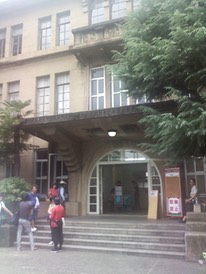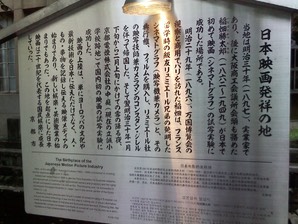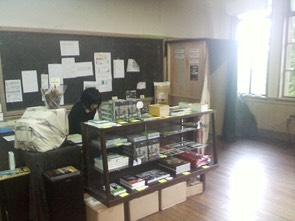The other day, I made a trip to Kyoto on Yale business. While there, I had the chance to meet with Moriwaki Kiyotaka, senior curator for film at the Museum of Kyoto. Markus Nornes and I are updating our Research Guide to Japanese Film Studies in preparation for a possible Japanese edition and I thought I'd check up on the Museum. Unfortunately, it does represent some of the problems film studies and archiving face in Japan. While their collection of materials is superlative (centered on the Ito Daisuke collection), their reading room no longer exists and scholars are only allowed to view the collection on a case by case basis. But it was great hearing from Moriwaki-san about how the Museum, despite these difficulties, is making use of what it has and even rethinking the role of archives. The Museum is not simply trying to preserve the artifacts of Kyoto's film culture, a culture largely centered around jidaigeki, but engineering opportunities for the knowledge of that film culture to live on in younger generations. Thus it is attempting, for instance, to put young anime and manga artists in touch with older film veterans so that the current fad for samurai and period manga/anime can actually feed off of a longer history.
After going to Kobe (which I'll report about next), I returned to Kyoto the next day with Yasui Yoshio of the Kobe Eiga Shiryokan, who on a whim took me to see the special theater of the Rissei Cinema Project. It's located inside the building of the former Rissei Elementary School, which is still standing next to the Takase River near Kawaramachi.

The school was actually built on the site of the Kyoto Electric Lighting Company, which in early February 1897, was also the site of the first screening of a motion picture film in Japan (note this was after the exhibition of Edison's kinetoscope, which was a non-projecting moving picture system). Inabata Katsutaro, a Kansai businessman, had brought the Lumiere's Cinematographe back with him from France and tested it at this location before exhibiting it commercially in Osaka soon afterwards. Kyoto has put up a sign outside the building that declares it "The Birthplace of the Japanese Motion Picture Industry."

What's intriguing is that the school building has not been used as a school in years and the Kyoto government has not decided what to do with it. Taking advantage of this inaction, a number of art and culture groups have begun using the building as gallery and performance space. It's grey area activity and may end at any moment (though I hope they don't tear down this wonderful building), but the location has become somewhat of locus of cultural activity.

Yasui-san brought me there because in April, a group of young people started a kind of jury-rigged movie theater on the third floor, the Rissei Cinema Project. Using two classrooms that happen to have a door connecting them, one classroom is used as the lobby and the other as the theater. As you can see from the photo, the front desk is right by the blackboard, with the entrance to the theater, complete with curtains, put together with plywood in the back. Since they don't know if and when they may be forced out, the theater itself is simple, with cloth used to block sound and no seats: you sit on the (raised) floor like the old ACT Mini Theater near Waseda. It's mostly video projection (the booth is right by the blackboard in that classroom), with the addition of some small-guage film projectors. They show everything from old Chaplin and Melies films to recent movies. There were no screenings the day I visited, but there were still people there. It's become kind of a hangout.
While I am all for preserving the artifacts of Japan's film culture - and making these readily available for students and scholars - I was very impressed this trip at the efforts to establish other connections with the cinematic past and find new ways to continue Kyoto's film culture. That is another, more active form of historiography or even archiving. I think it's more than appropriate that the birthplace of the movies in Japan is now occupied by some young cinematic squatters.

